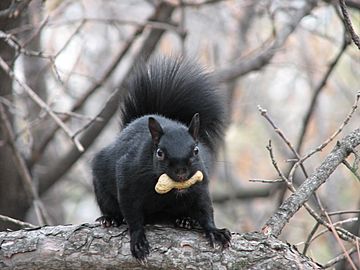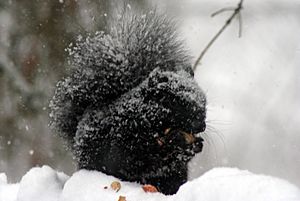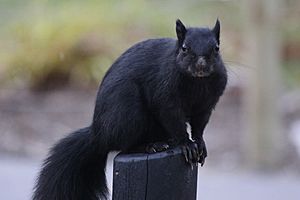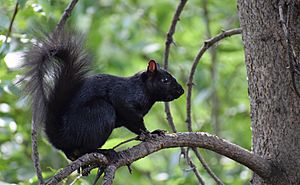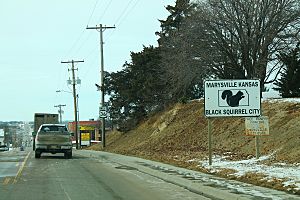Black squirrel facts for kids
Black squirrels are a special type of squirrel with black fur. This happens because of something called melanism, which means they have extra dark pigment. While black fur can appear in many squirrel species, it's most common in the eastern gray squirrel (Sciurus carolinensis) and the fox squirrel (Sciurus niger).
Black squirrels live in the same places as their gray or reddish cousins. But sometimes, black eastern gray squirrels were also brought to new areas. This happened in Canada, the United Kingdom, and the United States in the 1800s and 1900s.
You'll find black eastern gray squirrels most often near the Great Lakes Basin. Black fox squirrels are more common in the southeastern U.S.. Even so, black squirrels are still quite rare in most places. However, in Ontario, Canada, and Michigan, U.S., most eastern gray squirrels are black!
Some towns and colleges in the United States even use a black squirrel as their symbol or mascot. Some towns have even made rules to protect these special black squirrels.
Contents
What They Look Like
The black color in eastern gray squirrels and fox squirrels comes from a special gene. This gene is missing a small piece of its DNA. Scientists believe this "faulty" gene first appeared in black fox squirrels. Then, it was passed on to eastern gray squirrels when the two species mated.
Black fur can also be seen in Eurasian red squirrels and western gray squirrels. But it's much less common for western gray squirrels to be black. The black color in Eurasian red squirrels might be caused by different genes working together.
Why Black Fur Helps Them
Scientists have two main ideas about why black fur is helpful for squirrels. These ideas are about hiding and staying warm.
Hiding from Danger
Black eastern gray squirrels used to be more common. But their numbers went down after the 1700s. This might have been because of people cutting down forests and hunting squirrels. In new, open areas, gray squirrels could hide better.
Some think gray squirrels hide better in forests with deciduous trees (trees that lose their leaves). Black squirrels might hide better in forests with conifer trees (like pine trees). Conifer forests are often darker, making it easier for a dark squirrel to blend in.
When deciduous trees lose their leaves in winter, the forest becomes brighter. This might give gray squirrels an advantage. One study found that black fox squirrels were better at hiding when they were moving. Gray squirrels were better at hiding when they were still.
Black fox squirrels in the southeastern U.S. live in forests that sometimes burn. The black fur helps them hide better in these burned, dark areas.
Staying Warm
Black squirrels might be better at handling cold weather than gray squirrels. Animals with black fur lose less heat when it's very cold. They also use less energy to stay warm.
This ability to stay warm helps black squirrels live in colder places. It might have helped eastern gray squirrels spread further north after the last ice age. Black eastern gray squirrels have been seen as far north as Sudbury, Ontario.
A study in 2019 found that black fox squirrels got warmer faster in both sunny and cloudy weather. Gray fox squirrels only got warmer when it was sunny. This might be why black squirrels are more active on cold winter mornings.
How They Have Babies
When a gray squirrel and a black squirrel mate, they can have mixed-color babies.
- Gray squirrels have two "normal" copies of the pigment gene. They can't have black babies.
- Black squirrels have at least one copy of the "mutant" pigment gene.
- If a black squirrel has two copies of the mutant gene, it will be completely jet black.
- If it has one mutant gene and one normal gene, it will be brown-black.
About 9 out of 100 black eastern gray squirrels are jet black. In places where many black squirrels live, it's common to see litters with both black and gray babies.
Differences from Gray Squirrels
Some people call black squirrels "super squirrels," but a study in 1990 found no big differences in how black and gray eastern gray squirrels behave. They reacted the same way to humans or dog-like predators.
However, another study in 2010 found that gray squirrels were more likely to run away after hearing a red-tailed hawk. Black squirrels were less likely to run. This might be because black squirrels often live in cities. They might be more used to human sounds and city life.
A 2019 study on fox squirrels found that black fox squirrels were more active in winter and spring. They were especially active in the mornings. Gray fox squirrels were more active in the autumn. Black squirrels can be active earlier because their dark fur helps them warm up faster.
Where They Live
Black eastern gray and fox squirrels live in the same areas as their regular-colored relatives in North America. But they are usually very rare. It's thought that only 1 in 10,000 eastern gray squirrels is black.
Black eastern gray squirrels used to be more common in North America. But their numbers have gone down since the late 1700s, especially south of the Great Lakes.
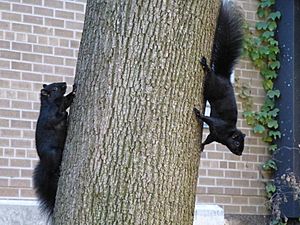
You'll find more black eastern gray squirrels in the northern parts of their range. This includes southern Canada and the northern United States. They are especially common around the Great Lakes.
Black squirrels are most common in Ontario and Michigan. In Ontario, about 66% of eastern gray squirrels are black. In Michigan, it's about 56%. Other states around the Great Lakes also have many black squirrels, about 15%. South of the Great Lakes, black squirrels are found in smaller, specific areas. They are also more common in cities than in rural areas or deep forests.
Black fox squirrels are most common in the southeastern United States. Their numbers vary, but can reach up to 13% in some places. Large groups of black fox squirrels can also be found in other areas, like Council Bluffs, Iowa. About half of the fox squirrels in Council Bluffs are black.
New Homes for Black Squirrels
Some black squirrel populations were introduced to new areas on purpose or by accident.
Bringing Them Back
Some black squirrel groups were brought to new places to help their numbers grow again. This happened in areas where hunting or predators had made their populations very small.
- Washington, D.C.: In 1902 and 1906, Teddy Roosevelt released 18 black squirrels from Ontario into parks around the National Mall. This was likely to help the local squirrel population grow. By the 1960s, they had spread.
- Battle Creek, Michigan: In 1915, John Harvey Kellogg released 400 eastern gray squirrels, including some black ones, to help repopulate the area. Later, in 1958 and 1962, black squirrels from Battle Creek were released at Michigan State University in East Lansing.
- Ohio: Black squirrels disappeared from Ohio by 1930. In 1961, Kent State University brought ten black squirrels from London, Ontario, to its campus. By 1964, their population had grown to 150. They have since spread through northeastern Ohio.
Accidental Introductions
Some black squirrel populations were introduced by accident. Some communities love them, while others see them as a problem.
- Quad Cities: Black squirrels appeared here in the 1800s. One story says they escaped from Rock Island Arsenal and crossed the frozen Mississippi River.
- Calgary, Alberta: Eastern gray squirrels, including black ones, were brought to British Columbia in the early 1900s. They also came to Calgary in the 1930s, mostly from escaped pets or zoo animals. Now, black squirrels are the most common type in Calgary.
- Marysville, Kansas: Black squirrels supposedly escaped from a circus exhibit in the 1920s. Marysville has embraced them as a symbol.
- Massachusetts: In the late 1940s, black squirrels from Michigan were released into Stanley Park in Westfield. They are still mostly found in that area.
- United Kingdom: Black eastern gray squirrels were brought to the U.K. from North America. No one is sure how they got there. Some say they escaped from zoos, others say they were released in the 1800s. The first wild black squirrel was seen in 1912. By 2009, they made up almost half of all squirrels in some parts of England. However, because eastern gray squirrels (both black and gray) can harm the local Eurasian red squirrel population, their spread is sometimes controlled.
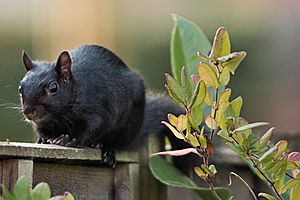
In Culture
Many cities and colleges in the United States use black squirrels as mascots or symbols.
The city of Marysville, Kansas, made the black squirrel its official mascot in 1972. They even have a "Black Squirrel Song" as their town anthem. Marysville has special rules to protect its black squirrels. For example, they can go anywhere in the city and have "first pick" of black walnuts. Council Bluffs, Iowa also has rules to protect them.
Several colleges also use a black squirrel as their mascot, like Albion College and Haverford College.
Other universities use the black squirrel as an "unofficial" mascot. Kent State University is one example. They even have an annual "Black Squirrel Festival" and a statue of a black squirrel on campus. The university's publishing house even named a book series "Black Squirrel Books." Colleges often use the black squirrel to help people remember them and make their campus seem fun.
Images for kids
-
Melanistic eastern gray squirrel in Santa Clara, California


